Battle of Nations. How the Allies crushed Napoleon's power
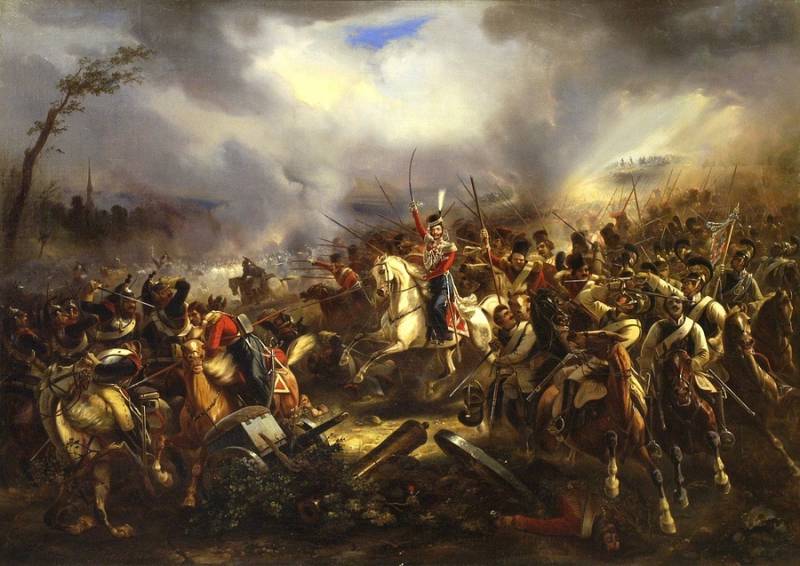
Attack of the Life Cossacks near Leipzig on October 4, 1813. Karl Rechlin
210 years ago, Napoleon's army was defeated by the allied armies of Russia, Austria, Prussia and Sweden. The Battle of Leipzig became the largest battle of the Napoleonic era and in the world stories before the First World War.
General situation
The military-strategic situation preceding the new decisive battle was favorable for the Allies. France was exhausted by continuous wars. The quality of reinforcements for the army fell sharply - young men and old people had to be thrown into battle, there was no time to train recruits. The French failed, after her death in Russia, to restore a full-fledged cavalry and artillery park. Napoleon lost some of his allies - the Prussians and Austrians became enemies, the Duchy of Warsaw was occupied. The rest of the allies did not want to fight - “Akela missed.” Except for the remaining Poles, who still fought bravely.
The sixth anti-French coalition, which included Russia, Prussia, Austria, England, Sweden, Spain, Portugal and a number of small German states, surpassed Napoleon's empire in all respects: the number of bayonets and sabers, guns, human resources, financial capabilities and economic potential.
For the time being, Napoleon could restrain the enemy only due to his unique military leadership talent. After the death of Kutuzov, no commander equal to the French emperor appeared in the ranks of his opponents. Also, the allied armies were constrained by the lack of unity of command and poor interaction.
Napoleon was able to defeat the allies at Lützin, Bautzen and Dresden (Napoleon's victory in the battle of Dresden). However, his hopes for the collapse of the allied coalition were not justified. The Allies easily compensated for the losses and even increased the number of troops. Their goal remained the same - the defeat of the empire of Napoleon Bonaparte. The plan of the allied command began to justify itself: to beat the enemy corps and army groups separately. The Allies destroyed Vandam's corps near Kulm (Guard stand and die), defeated Ney's corps at Dennewitz and Bertrand's corps at Wartenburg.
The French could not quickly make up for these losses; the numerical advantage of the allied army became more and more obvious. Therefore, with the arrival of new troops, the Allies decided to go on a decisive offensive again in order to encircle and destroy the enemy. Napoleon's army at this time remained in the Dresden area in eastern Saxony.
The Silesian army under the command of Blucher bypassed Dresden from the north and crossed the Elbe River north of Leipzig. The Northern Army of the Swedish Crown Prince Bernadotte joined with it. Schwarzenberg's main (Bohemian) army, having pushed back Murat's troops, bypassed Dresden from the south and also headed towards Leipzig, to Napoleon's rear. Prussian troops came from the northern direction from Wartenburg, Swedish - also from the north, but in the second echelon after the Prussians, Russian and Austrian - from the south and west.
Bonaparte was not afraid of battle; on the contrary, he hoped to finally defeat the enemy and win the entire campaign. He left a strong garrison in Dresden and moved the army towards Leipzig, planning first to defeat Blücher and Bernadotte, and then Schwarzenberg. However, the French emperor overestimated his forces, the quality of which had seriously deteriorated compared to previous campaigns, underestimated the enemy and did not have complete data on the strength of the allies with reinforcements. In particular, Napoleon mistakenly believed that the Silesian army was located much further north, further from Leipzig, and doubted the rapid appearance of the Bohemian army. But the main army of the Allies arrived earlier, and therefore the battle plan had to be changed.
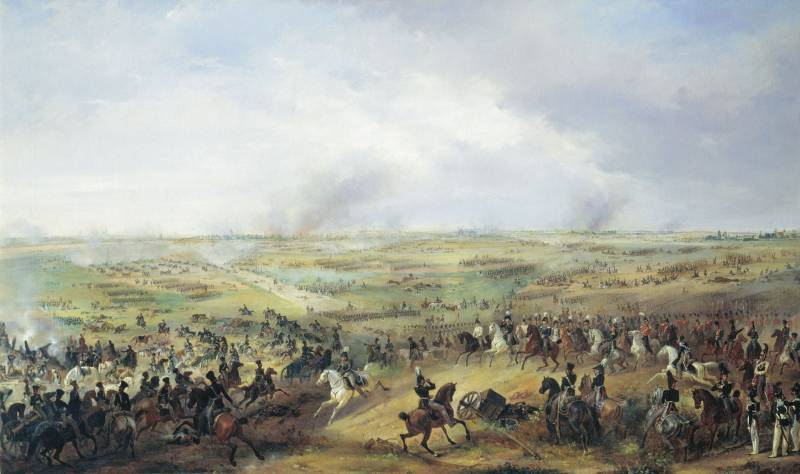
Battle of Leipzig, A. I. Sauerweid
The forces of the parties
By the beginning of the battle, the Bohemian Austro-Russian-Prussian Army - 133 thousand people, 578 guns and the Silesian Russian-Prussian Army - 60 thousand soldiers, 315 guns had reached Leipzig. At the beginning of the battle, the allied forces numbered about 200 thousand people.
Already during the battle, the Northern Prussian-Russian-Swedish army pulled up - 58 thousand people, 256 guns, the Polish Russian army under the command of General Bennigsen - 46 thousand soldiers, 162 guns and the 1st Austrian corps under the command of Colloredo-Mansfeld - 8 thousand .men, 24 guns. At the beginning of the battle, Bernadotte's Northern Army was in Halle (30 km north of Leipzig), and Bennigsen's Polish Army was in Waldheim (40 km east of Leipzig). During the battle, the size of the allied army increased to 310 thousand people (according to other sources, up to 350 thousand) with almost 1 guns.
The allied army included 127 thousand Russians, 89 thousand subjects of Austria - Austrians, Hungarians, Slavs, 72 thousand Prussians, 18 thousand Swedes, etc. The commander-in-chief of the allied forces was the Austrian field marshal Prince Karl Schwarzenberg. However, his power was limited by the monarchs, so Emperor Alexander I constantly intervened in the operational leadership. In addition, the commanders of individual armies and even corps had greater independence in decision-making.
Napoleon's army consisted of about 200 thousand soldiers (according to other sources, about 150 thousand people) and 700 guns. Near Leipzig, the French had 9 infantry corps - more than 120 thousand soldiers, Guard - 3 infantry corps, a cavalry corps and an artillery reserve, a total of up to 42 thousand soldiers, 5 cavalry corps - 24 thousand people, plus the Leipzig garrison - about 4 thousand . Human. Most of the army were French, but there were many different kinds of Germans, Italians, Poles, Belgians, Dutch, etc.
In total, up to half a million soldiers took part in the battle. Therefore, the battle of Leipzig was called the “Battle of the Nations.”
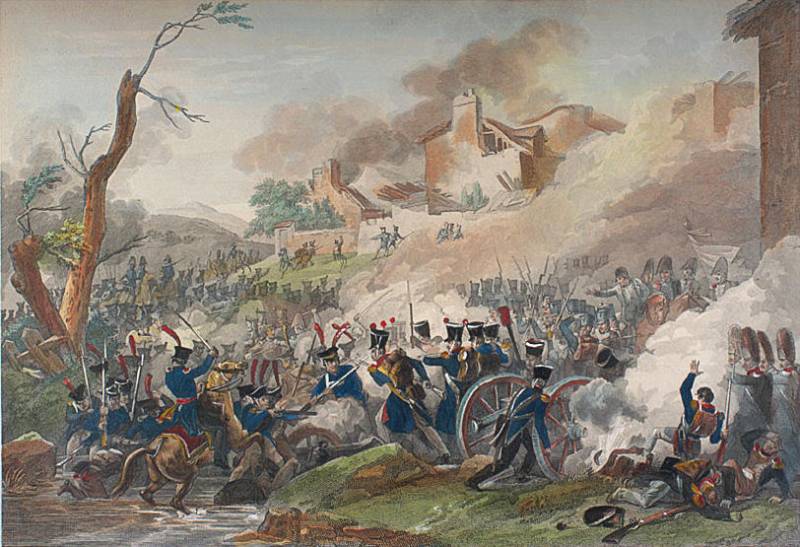
Battle of Leipzig. Colorized XNUMXth century engraving
On October 3 (15), Napoleon positioned his troops around Leipzig. The main body of the army covered the city from the south along the Plaise River, from Connewitz to the village of Markkleiberg, then further east through the villages of Wachau, Liebertwolkwitz and to Holzhausen. The road from the western direction was blocked by Bertrand's corps (12 thousand people), which was stationed at Lindenau. From the northern direction, Leipzig was defended by the troops of Marshals Marmont and Ney - 2 infantry and 1 cavalry corps (up to 50 thousand soldiers).
The French monarch was going to strike the Bohemian army on October 4 (16) and defeat it, or at least seriously weaken it, before the rest of the enemy forces arrived. For the offensive, a strike force of 5 infantry, 4 cavalry corps and 6 guard divisions was created, totaling about 110–120 thousand soldiers. It was led by Marshal Murat.
The Allied command, under pressure from the three monarchs Alexander I, Frederick William III and Franz I, also planned to conduct attacking actions, fearing that Napoleon, taking advantage of his central position, could separately defeat the Northern Army, holding back the Bohemian Army with a strong barrier. There was also hope to defeat the French army piece by piece.
Schwarzenberg decided in the morning to strike from the south with the forces of the Bohemian Army. Initially, the Austrian field marshal proposed throwing the main forces of the army into the Connewitz area, breaking through the enemy’s defenses in the swampy lowlands of the Plaisse and Weisse-Elster rivers, bypassing the enemy’s right flank and taking the shortest western road to Leipzig. The Russian sovereign criticized the plan, pointing out the complexity of the terrain.
The Bohemian army was divided into three groups and a reserve. The first (main) group of Barclay de Tolly - it included the 4th Austrian corps of Klenau, the Russian troops of General Wittgenstein and the Prussian corps of Field Marshal Kleist (total 84 thousand people, 404 guns). Barclay's group was supposed to hit the French army on the Krebern - Wachau - Liebertvolkwitz front, actually attacking the enemy head-on, from the southeast.
The second group was commanded by the Austrian General Maximilian von Merfeld. It included the 2nd Austrian Corps and Austrian reserves, a total of 30–35 thousand people with 114 guns. He was supposed to advance between the rivers Place and Weise-Elster, capture the crossings and strike the right flank of the French army.
The third detachment under the command of Ignaz Gyulai (Giulai) was supposed to attack from the west, towards Lindenau and seize the crossing over the Weisse Elster west of Leipzig. The group was supposed to intercept the enemy's escape route to the west. The basis of Gyulai's detachment was the 3rd Austrian Corps - about 20 thousand people. The Russian-Prussian Guard formed a reserve.
Blücher's Silesian army was to launch an offensive from the north on the Möckerk-Wiederitz front.
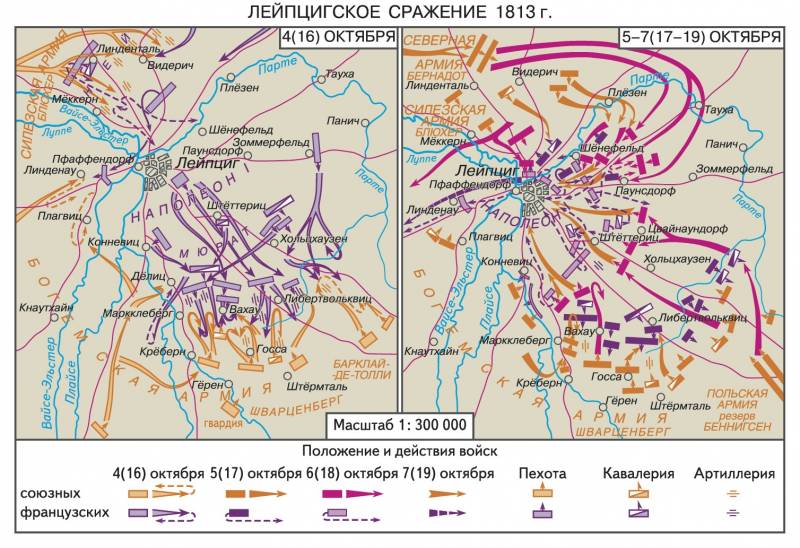
Allied offensive and French counter-offensive
On the morning of October 4 (16), Russian and Prussian troops opened artillery fire and began to approach the enemy. The battle boiled down to a series of fierce battles for Markkleeberg, Wachau, Liebertwolkwitz, as well as the crossing at Connewitz. Russian-Prussian troops under the command of Kleist captured the village of Markkleeberg at about 9:30 a.m. Here French-Polish troops held the defense under the command of Marshals Augereau and Poniatowski. Four times the French and Poles recaptured the village and four times the Russians and Prussians again took Markkleeberg by storm.
The village of Wachau was also captured by Russian-Prussian troops under the command of Duke Eugene of Württemberg. Due to heavy fire from French artillery, the village was abandoned by noon. Liebertwolkwitz was stormed by Russian-Prussian troops under the overall command of Gorchakov. The defense was held by the corps of General Lauriston and Marshal MacDonald. After a stubborn battle, when they had to fight for every street and house, the village was occupied. Both sides suffered heavy losses. Then the French received reinforcements - the 36th division, and recaptured the position.
The offensive of the Austrian 2nd Corps was unsuccessful, and in the afternoon, when the French counteroffensive began, Schwarzenberg sent Austrian troops to help Barclay. Gyulai's attack on Lidenau by the Austrian 3rd Corps was also unsuccessful.
The Bohemian army lost its offensive impulse and went on the defensive. Napoleon decided to deliver the main blow to the center of enemy positions in the general direction of Wachau - Guldengoss. At 15:10, Murat's French cavalry (about 160 thousand horsemen), supported by a strong artillery group - XNUMX guns of General Drouot, delivered a powerful blow. French cuirassiers and dragoons, supported by infantry and artillery, broke through the Russian-French line.
The allied monarchs and Schwarzenberg were under threat, and the enemy cavalry broke through to the hill where they watched the battle. The French were already several hundred meters away, pursuing the fleeing. They were saved by a counterattack by the Life Guards Cossack Regiment under the command of Ivan Efremov. The Cossacks and a company of Russian artillery held back the enemy's onslaught until reinforcements arrived. Palen's cavalry detachment, a grenadier division from Raevsky's corps, and a Prussian brigade from Kleist's corps were thrown against the French cavalry. Fresh units finally stopped the enemy and closed the gap in the front.
Napoleon, wanting to defeat the enemy before new formations arrived, decided to throw the Guard into battle. But he had to divert part of his forces to repel an Austrian attack on his right flank. The guards went to help Poniatowski. The Austrians were driven back, their commander Merfeld was captured by the French.
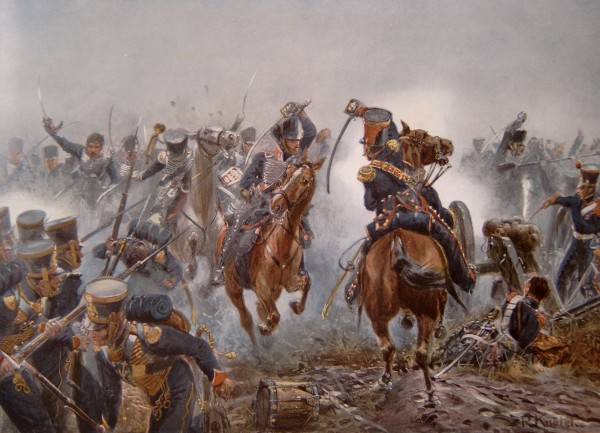
Brandenburg Hussars near Möckern, Leipzig, October 16, 1813. Artist Richard Knotel
Blücher's kick
Blücher's army attacked in the area of Wiederitz and Möckern. The Prussian commander did not wait for Bernadotte’s approach and went on the offensive. The village of Wiederitz was defended by the Polish general Dombrowski, who spent the whole day holding back the onslaught of Langeron's Russians.
Marmont's corps defended positions in the area of the village of Möckern. The marshal received orders to move south to Wachau to take part in the main battle. Having received news of the approach of the enemy from the north, he stopped and sent Ney a request for help. York's Prussian corps, after stubborn fighting, took the village, suffering heavy losses. The French corps was defeated. The Silesian army broke through the French defenses north of Leipzig, and the forces of Marmont and Ney were unable to take part in the key Battle of Wachau.
With the onset of darkness the battle ended. Most of the battlefield remained with the French army. The French pushed back the Allied forces from Wachau to Guldengossa and from Liebertwolkwitz to the University Forest, but were unable to achieve a decisive victory.
In general, the first day of the battle did not meet the hopes of either the French or the allies, although the battle was extremely stubborn. Both sides suffered huge losses - up to 60-70 thousand people. The places of the most brutal battles were simply littered with corpses. Prussian soldiers from Blucher's army made positions out of corpses, determined to hold the captured lines. On the night of October 5 (17), fresh Northern and Polish armies arrived. Now the allied army had a serious superiority over the enemy.
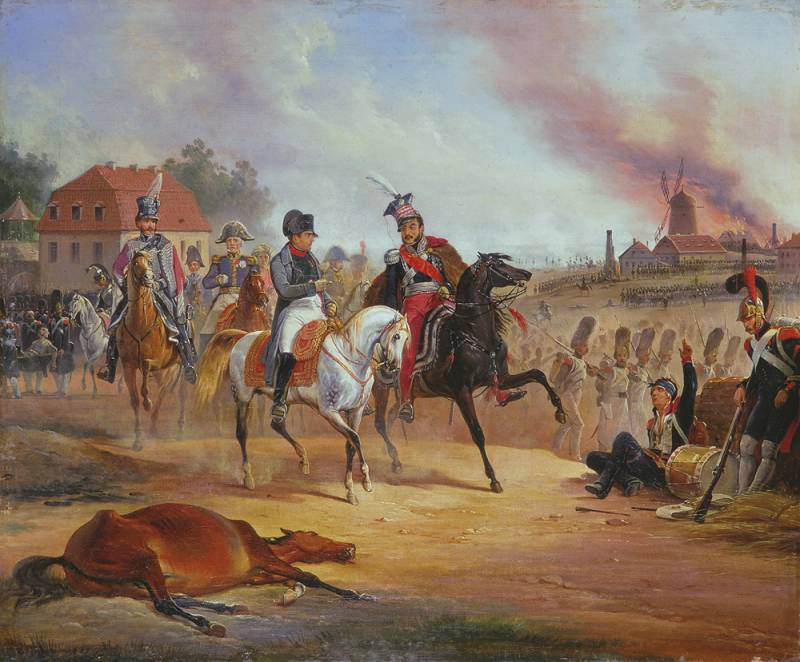
Napoleon and Poniatowski near Leipzig. Hood. January Sukhodolsky
Attempt to negotiate a truce
Napoleon understood the danger of the situation, but did not leave his position at Leipzig. He decided to call a truce to begin a new round of peace negotiations. With the help of the Austrian general Merfeld, Bonaparte sent a letter to all allied monarchs proposing a ceasefire and the beginning of peace negotiations. Napoleon expressed his readiness to make big concessions: to forget about the already lost Duchy of Warsaw, and also to give up Holland and the Hanseatic cities, restore the independence of Italy, and abandon the Union of the Rhine and Spain.
That is, in fact, this was what the allies had previously demanded. Napoleon asked only that England return the captured colonies. The allied monarchs did not respond. Obviously, they decided that this was a sign of weakness, and the enemy needed to be finished off.
In general, the day of October 5 (17) passed calmly, both sides were looking for the wounded and burying the dead. Only in the northern direction did Blucher’s troops continue their offensive and, having captured the villages of Eitrich (Oitritzsch) and Golis, came close to Leipzig itself.
At 2 o'clock in the afternoon a military meeting was held in the village of Zestevitz. Schwarzenberg proposed to immediately resume the battle. Bennigsen reported that his army was tired from the long march and needed rest. It was decided to resume the offensive the next morning. Bennigsen's army was supposed to attack on the right flank, together with the 4th Austrian corps.
The French regrouped their forces on the night of October 6 (18). The old positions, which it was unreasonable to defend due to lack of strength, were abandoned. The troops retreated to a distance of approximately 1 hour from the city. By morning, French troops took up positions on the line Lindenau - Connewitz - Holzhausen - Schönefeld. New positions were defended by up to 150 thousand soldiers with 630 guns. Napoleon's headquarters were located at Stötteritz.
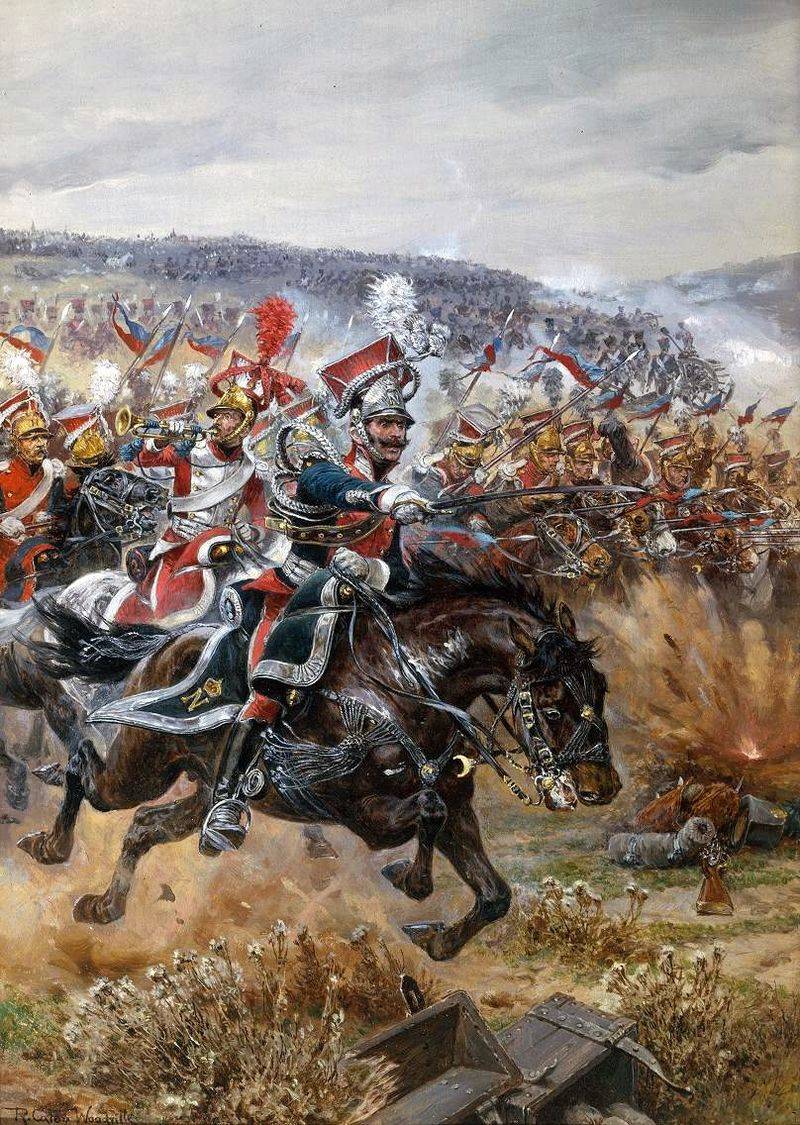
Richard Cayton Woodville. "Poniatowski's last attack at Leipzig"
Second Allied offensive
On the morning of October 6 (18), the allied forces launched an offensive. The columns advanced unevenly, some started moving later, and as a result of a simultaneous attack along the entire front, it did not work out. The Austrian troops of the Prince of Hesse-Homburg were advancing on the left flank. The Austrians attacked French positions at Dölitz, Deusen and Lösnig. They tried to push the French away from the Place River. First they captured Dölitz, and at about 10 o'clock - Dösen.
The battle was difficult, the French fought much harder than was necessary to cover the retreat. They constantly counterattacked. The Prince of Hesse-Homburg was seriously wounded, and Colloredo took command. He himself was wounded in the chest, but hid it from those around him, continuing the battle at Konnewitz and Dölitsa. The Austrians made their way to Connewitz, but then two French divisions sent by Napoleon arrived under the command of Oudinot. The French counterattacked and the Austrians withdrew from Connewitz. They also left Dezen. The Austrians retreated, regrouped their forces, and went on the offensive again. By lunchtime they captured Lösnig, but were unable to re-occupy Connewitz, which was defended by the Poles and the Young Guard of Oudinot and Augereau.
A stubborn battle broke out in the center, in the area of Probsthaid (Probsthaida), where the troops of Victor and Lauriston held the line. The village had a stone fence and was an important center of French defense. First, two Prussian brigades from Kleist's corps went on the attack. Prussian soldiers were able to make their way into the village from the eastern side, but were met with grapeshot fire and retreated. Then the Russian corps of Eugene of Württemberg went on the attack. Russian-Prussian troops burst into the village.
Napoleon threw the Old Guard into battle with the support of Drouot's guard artillery. The French recaptured the village. But their further advance was stopped by strong artillery fire. Both sides suffered heavy losses. The battle continued into the night, but the allies were unable to break through to Probstaida.
Bennigsen's army was advancing on the right flank. She moved towards the enemy very late, at about 2 o'clock in the afternoon. Russian troops captured Zukelhausen, Holzhausen and Paunsdorf. Troops of the Northern Army also took part in the assault on Paunsdorf - the Prussian corps of Bülow and the Russian corps of Winzingerode.
In the north, the troops of Langeron and Sacken (Silesian Army) captured Schönefeld and Golis. In the midst of the battle, Napoleon's German allies betrayed him. The entire Saxon division (3 thousand soldiers, 19 guns) went over to the side of the allies, the Saxons were followed by Württemberg, Westphalian and Baden units. This seriously complicated Leipzig's defense. The Saxons immediately took the side of the allied army. However, this did not save Saxony; the victors dismembered it.
In the eastern and northern directions, French troops were pushed back to a distance of a 15-minute march from the city. In the western direction, the Austrians were not active that day. Schwarzenberg doubted the need to force Napoleon into a final life-or-death battle. Therefore, he ordered Gyulai's III Corps to only observe the French and not to storm Lindenau.
Retreat of the French army
The situation for the French became critical. The enemy had overwhelming numerical superiority. The German allies betrayed and went over to the enemy. The city was not preparing for a siege, the army was not ready for a long battle. Ammunition was running out. According to the report of the chief of artillery, the army spent 220 thousand cannonballs in a few days, leaving only 16 thousand shells. It was necessary to leave in order to save the army.
There were no preparations for withdrawal, so there was only one bridge and the French could retreat only in one direction to Weissenfels. In the vanguard was Bertrand's corps, which covered Lindenau. On the night of October 7 (19), the rest of the troops followed him, first the Guard, artillery and the corps of Victor and Augereau. The troops of MacDonald, Ney and Lauriston were supposed to cover the retreat.
The Allies made a big mistake by deciding that the enemy would continue the battle. Therefore, the left flank was not strengthened in advance. Tsar Alexander's proposals to concentrate efforts on crossing the River Pleisse and Weisse-Elster, and Blücher to create a powerful cavalry group to pursue the enemy, were not implemented. The Austrians, who received Schwarzenberg's orders, did not particularly interfere with the enemy.
While the French were retreating through the western Randstadt Gate, the Allies began to advance. The French army retreated along one road, this led to chaos. Napoleon himself had difficulty getting out of the city. The Russian troops of Langeron and Osten-Sacken occupied the eastern suburb of Halles, the Prussians of Bülow - the suburb of Grimmas, Bennigsen's troops captured the southern gate of Leipzig - Peterstor.
The chaos in the French army reached its peak when sappers mistakenly blew up the Elsterbrücke Bridge, which was located in front of the Randstadt Gate. Hearing the distant cries of “Hurray!”, they decided that it was necessary to stop the enemy’s advance and destroyed the bridge, which was full of soldiers.
There were still about 20–30 thousand French left in the city, including Marshals MacDonald and Poniatowski and Generals Lauriston and Rainier. Their morale was undermined, since there was nowhere to retreat. The old guard, which was preparing to cover the rear corps, could now not help them.
The hospitals did not have time to evacuate either. Many died, including while trying to swim across the river and climb the steep opposite bank under enemy fire; others were captured. MacDonald swam across the river. Poniatowski, who fought well in the Battle of Leipzig and was the only foreigner in Napoleon's service to receive the rank of French marshal, was wounded and drowned during the crossing. Lauriston was captured. By one o'clock in the afternoon the city was completely captured.
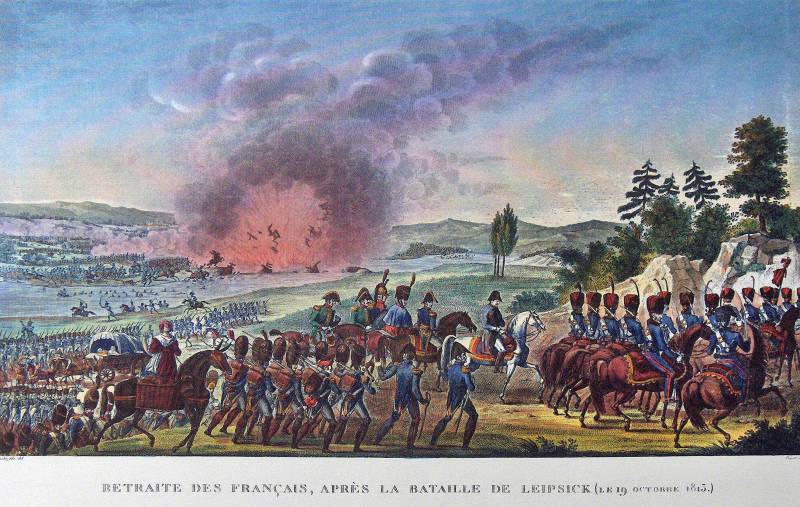
Retreat of the French army after the Battle of Leipzig, October 19, 1813. Colored engraving from the XNUMXth century.
Results
Napoleon's army suffered a heavy defeat, but avoided disaster. In many ways, the French were saved by the mistakes of the allied command. Neither Schwarzenberg nor the council of the three emperors were able to fully manage the military operations of the huge allied army. Good chances to end the war in Leipzig were lost.
French troops lost approximately 70–80 thousand people: 40 thousand killed and wounded, 30 thousand prisoners (including those captured in hospitals), several thousand Germans went over to the side of the allied army. Also, a typhus epidemic began in the French army, and Napoleon was able to bring only about 40 thousand soldiers to France. The French army lost one marshal and three generals killed; the king of Saxony, two corps commanders (except Lauriston, captured the commander of the 7th corps, Rainier), and two dozen divisional and brigadier generals were captured. The army lost half of its artillery - 325 cannons, 960 charging boxes, 130 thousand guns (including Leipzig arsenals) and most of the convoy.
The Allied forces also suffered heavy losses - up to 54 thousand killed and wounded, of which up to 23 thousand Russians (8 generals were killed or mortally wounded - Neverovsky, Shevich, Gine, Kudashev, Lindfors, Manteuffel, Rhubarb and Schmidt), 16 thousand . Prussians, 15 thousand Austrians and 180 Swedes. The low losses of Swedish troops are explained by the fact that Bernadotte was saving troops for the war with Denmark for Norway. The Russians took the main blows of the enemy in the battle.
The defeat of Napoleon's army had a great military-strategic and political effect. Napoleon's troops retreated across the Rhine River to France. The fortresses remaining behind the French, many of which were already deep in the rear of the Allies, were doomed and began to surrender one after another. By January 1814, all French fortresses along the Vistula, Oder and Elbe had capitulated, except for Hamburg (it was defended by Napoleon’s “iron marshal” - Davout, he surrendered the fortress only after Napoleon’s abdication) and Magdeburg. They held out until May 1814. The capitulation of the fortress garrisons deprived Napoleon of about 150 thousand soldiers and a huge amount of artillery necessary for the defense of France. In Dresden alone, about 30 thousand people surrendered with 95 guns of field troops and 117 fortress cannons.
France was left alone against an entire coalition. Subject to Emperor Napoleon, the Rhine Confederation of German states collapsed. Bavaria took the side of the anti-French alliance, and Württemberg followed suit. Saxony was withdrawn from the war. Almost all small German state entities joined the coalition. France began withdrawing troops from Holland. Denmark was isolated by Swedish troops and, under pressure from Sweden and England, was forced to capitulate.
One of Napoleon's leading commanders, King Murat of Naples, concluded a secret treaty with Austria and moved his forces against the troops of the Kingdom of Italy, led by Eugene Beauharnais. True, Murat avoided active hostilities, played for time and conducted secret negotiations with Napoleon. The great Frenchman was left alone with France against the forces of almost all of Europe.
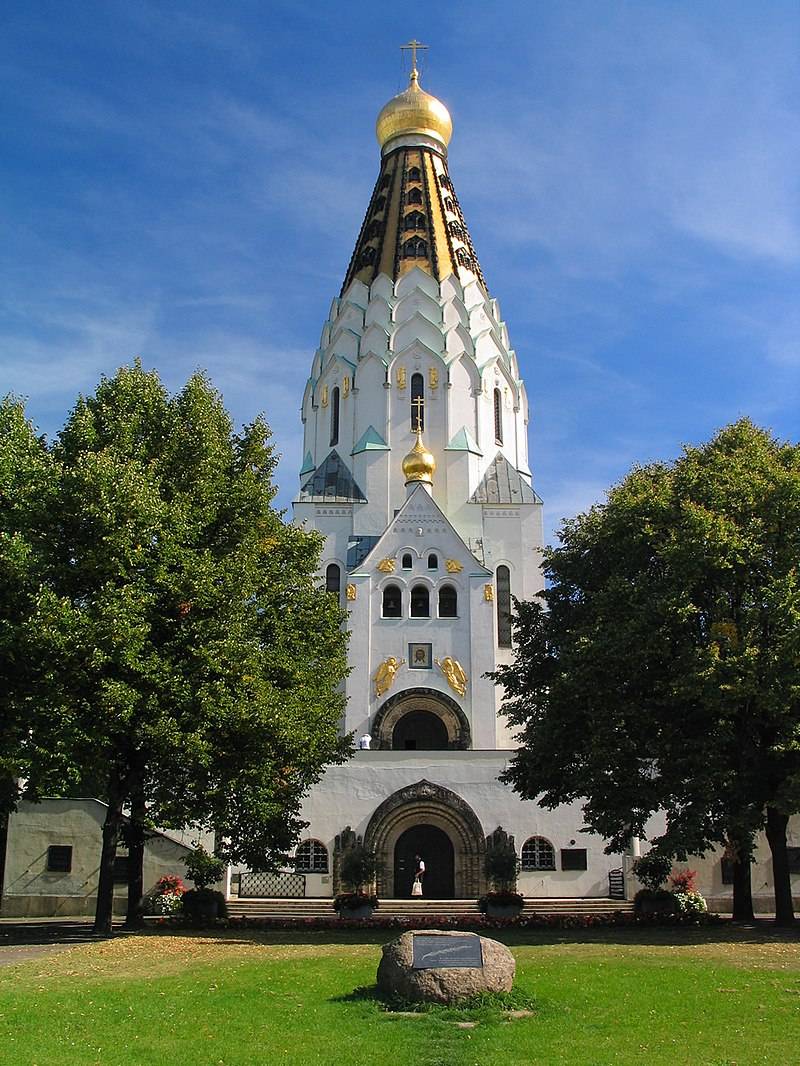
Temple-monument to Russian glory in Leipzig. Architect Vladimir Pokrovsky. 1913
Information